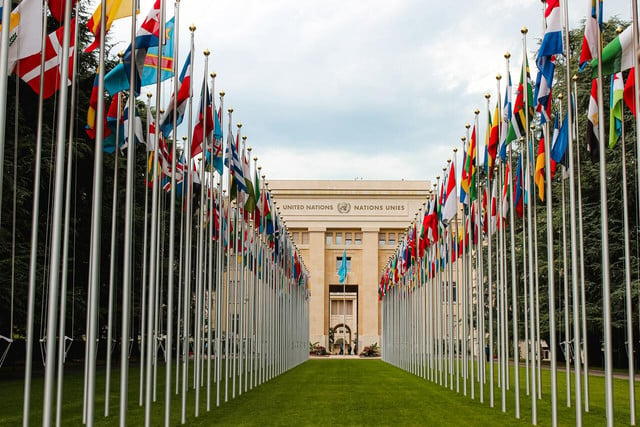The Paris Climate Agreement, also known as the Paris Climate Accords, is a global treaty that binds the world in a single effort to combat climate change.
Taking place in, you guessed it, Paris in December 2015, the world had never quite seen anything like the momentous signing of the Paris Climate Agreement. Some 195 signatories (nations and groups such as the European Union) from around the globe put politics aside for a few days to create a clear, coherent global strategy for tackling climate change.
The Paris Climate Agreement is essentially the only international, legally binding goal that the US (and almost the entire world) has agreed to follow. Its signing into action was an enormous step, as it signaled global recognition of the reality of climate change.
But what exactly was agreed upon? And is it too late to hold onto the promises made? We’ll do a quick run-down of the Paris Climate Agreement and where we currently stand.
Who Is Part of the Agreement, and Who Is Not?

(Foto: Photo: CC0 Public Domain / Unsplash - Mathias Reding)
As of September 2022, 194 out of 198 members of the United Nations Framework Convention on Climate Change (UNFCCC), including all G20 nations, are signatories to the Paris Climate Agreement. Turkey and Iraq are the newest signatories, joining the cohort in late 2021.
The four nations who have not (yet) signed are Iran, Libya, Yemen and Eritrea. Iran and Libya are part of the Organization of Petroleum Exporting Countries (Opec), whose own goals conflict with those of the Paris Agreement. Having all nations on board, particularly large and influential nations such as Iran, is important to guarantee the success of the pledge. However, it’s worth pointing out that these nations contribute minimally to global gas emissions: Iran’s contribution is 1.85 percent, Yemen’s 0.03 percent, and Eritrea and Libya’s are 0.01 and 0.14 percent respectively.
Under the Trump administration, the US withdrew from the agreement, though rejoined a few years later in 2021, on successor President Biden’s very first day of office. Since then, the US has made several big steps toward reducing its greenhouse gas emissions.
What Was Agreed?



(Foto: CC0 / Pixabay / 358611)
The agreement saw all signatories agree to contribute individually and work collaboratively to limit global temperature rise to under 2°C above pre-industrial levels by 2030, with 1.5°C being the target. This is not an arbitrary figure — 1.5°C is considered the maximum rise in global temperature whereby the planet will likely avoid the worst consequences of climate change.
Despite it being just half a degree, the difference between a rise of 2°C and 1.5°C is enormous. For example, droughts are already becoming more common and severe with our current global temperature rise of 1.1°C. However, with a 2°C increase in global temperatures:
- Almost three times the amount of people would regularly face extreme heat than those in a 1.5°C scenario.
- We will have an ice-free arctic within just a decade, which in turn will result in 170 percent more flooding due to climate change than we see currently.
- Our biodiversity will free-fall — all of the world’s coral will die thanks to a rise in sea temperatures and we stand to lose 18 percent of insects, 16 percent of plants and 8 percent of vertebrates.
These are just three examples of what we can expect if the maximum global temperature rise goals settled upon in the Paris Climate Agreement aren’t met.
The Paris Climate Agreement further states that the world should aim for net zero emissions by 2050. This means cutting greenhouse gas emissions to as close to zero as possible. Any emissions should be, by 2050, circulated out of the atmosphere, for example by our oceans and forests.
Needless to say, this will be one of humanity’s biggest challenges to date.
How Will It Be Achieved?
Individual action
Nations must create and submit their own increasingly ambitious plans known as Nationally Determined Contributions (NDCs) for tackling greenhouse gas emissions and building resilience in their own countries every five years. These can include individual targets for the reduction of CO2 or methane, dates for achieving carbon neutrality, and so on.
Participants are also invited to submit long-term low greenhouse gas emission development strategies (LT-LEDS). These are not mandatory but are important for contextualizing the NDCs and provide a vision for future development.
Accountability
Enormous efforts from all participating nations are required for us to be able to reach the targets set out by the Paris Climate Agreement. Every single nation must commit to reducing greenhouse gas emissions, and progress will be assessed during a Global Stocktake that takes place every five years and lasts for two. The first stocktake began at COP 26 in Glasgow in November 2021 and will conclude in the UAE at COP28 in 2023.
Cooperation
The specific action each country takes depends on that individual nation. However, the Paris Agreement addresses that certain countries are at an inherent advantage when it comes to achieving their goals, and some are at a distinct disadvantage. Cooperation and assistance between nations is a central part of the agreement. This comes in three forms:
Finance: The onus should be on richer nations to provide financial support to poorer nations to help them reach their targets.
Technology: Nations should fully utilize technology to improve resilience to climate change while also reducing greenhouse gas emissions.
Capacity-building: Developing nations do not have the same capacities to cope with climate change as developed nations. Developed nations should assist in enhancing the capacity of less developed nations.
Pros, Cons and Final Thoughts



(Foto: Photo: CC0 Public Domain / Unsplash - Tania Malréchauffé)
The Paris Climate Agreement is one of the boldest and most decisive pieces of legislation this generation has ever seen. Unlike the 1997 Koyoto Protocol, whose failure to incorporate binding targets for all signatories meant that it only had limited success, the Paris Climate Agreement requires all countries to set emissions-reduction pledges and is legally binding for all. This means that nations can be held accountable by international law if they do not do enough to reduce their greenhouse gas emissions.
Many say that 1.5°C above pre-industrial levels is too ambitious of a target to reach by 2030. Reaching the target would require the world to work together (which already sounds like a pipe dream) to almost half CO2 emissions from 2010 levels, an astronomic and infinitely complicated task that “scientists, financiers, negotiators and activists at COP26 are debating how to achieve and pay for“.
However, despite the critiques, the Paris Climate Agreement has achieved one thing already — almost all of the governments on earth agree that climate change is real, it’s here, and that action must be taken on a global scale — now.
Read more:
- What is Sustainable Development and Why Is It Necessary?
- What Causes Floods & How Does Climate Change Contribute?
- Climate Change Denial: How to Stand Up To Skeptics
Do you like this post?






